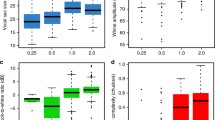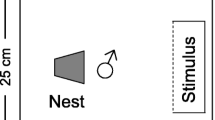Abstract
Bright colouration appearing in one sex only can be driven by components of sexual selection including female choice, male competition or mate recognition. Male Litoria wilcoxii undergo rapid colour change from brown to yellow during amplexus, however, the function, if any, is unknown. We tested possible behavioural functions by observing breeding aggregations and behavioural responses (colour change, movement, call and amplexus duration) to varying stimuli (including model male and female frogs). We also examined whether colour change was a by-product of hormone release by comparing spermatic urine of frogs injected with epinephrine (colour change hormone) and hCG (triggers spermiation). Finally, the predation cost of being bright yellow was examined by placing frog models (yellow and brown) in the field and measuring predator attack rate. The behavioural responses of males to model females, brown/brown models (female with amplexing brown male), and brown/yellow models (female with amplexing yellow male), were similar to reactions towards real females, with the important exception that males did not attempt amplexus with brown/yellow models. Epinephrine injections triggered colour change but not sperm release in male frogs, while hCG induced sperm release but not colour change. Attack rates were low in predation trials with no difference in attack rates between yellow and brown models observed. Our study presents a novel function for rapid dynamic colour change as an intrasexual signal during amplexus that could avert sperm competition and displacement by other males.
Significance statement
Colour displays during breeding are believed to have evolved through mechanisms of sexual selection (female choice, male–male competition or sexual recognition). Stony creek frogs (Litoria wilcoxii) have been observed to rapidly change colour from brown (similar to female colouration) to bright yellow during amplexus, which is unusual as the colour change occurs after mate selection. Behavioural experiments were used to test hypotheses on the evolutionary function of colour change in this species. In L.wilcoxii, colour functions as an intrasexual signal during amplexus, we hypothesise that this could avert sperm competition and/or displacement by other males during amplexus. The function presented here is novel among amphibians, however as data on dynamic colour change in amphibians is lacking, this trait may be more common.



Similar content being viewed by others
References
Adobe Systems (2010) Adobe Photoshop Extended vol C35. Adobe Systems Incorporated, San Jose, California
Aho AC, Donner K, Helenius S, Larsen LO, Reuter T (1993) Visual performance of the toad (Bufo bufo) at low light levels: retinal ganglion cell responses and prey-catching accuracy. J Comp Physiol A 172:671–682
Andersson M (1982) Sexual selection, natural selection and quality advertisement. Biol J Linn Soc 17:375–393
Andersson M (1994) Sexual selection. Princeton University Press, Princeton, NJ
Anstis M (2013) Tadpoles and frogs of Australia. New Holland Publishers, Sydney
Arak A (1983) Male–male competition and mate choice in anuran amphibians. In: Bateson P (ed) Mate choice. Cambridge University Press, Cambridge, pp. 181–210
Bell RC, Zamudio KR (2012) Sexual dichromatism in frogs: natural selection, sexual selection and unexpected diversity. Proc R Soc Lond B 279:4687–4693
Bittner TD (2003) Polymorphic clay models of Thamnophis sirtalis suggest patterns of avian predation. Ohio J Sci 103:62–66
Byrne PG, Silla AJ (2010) Hormonal induction of gamete release, and in-vitro fertilisation, in the critically endangered southern corroboree frog, Pseudophryne corroboree. Reprod Biol Endocrin 8:144
Cooper W, Greenberg N (1992) Reptilian coloration and behavior. In: Gans C, Crews D (eds) Biology of the Reptilia. University of Chicago Press, Chicago, pp. 298–422
Cummings ME, Bernal XE, Reynaga R, Rand AS, Ryan MJ (2008) Visual sensitivity to a conspicuous male cue varies by reproductive state in Physalaemus pustulosus females. J Exp Biol 211:1203–1210
Doucet SM, Mennill DJ (2010) Dynamic sexual dichromatism in an explosively breeding Neotropical toad. Biol Lett 6:63–66
Duellman WE, Trueb L (1986) Biology of amphibians. Johns Hopkins University Press, Baltimore
Endler JA (1978) A predator’s view of animal color patterns. Evol Biol 11:319–364
Endler JA (1980) Natural selection on color patterns in Poecilia reticulata. Evolution 34:76–91
Gay F, Valiante S, Sciarrillo R, De Falco M, Laforgia V, Capaldo A (2010) Annual and daily serum aldosterone and catecholamine patterns in males of the Italian crested newt, Triturus carnifex (Amphibia, Urodela). Ital J Zool 77:384–390
Glaw F, Vences M (2007) A field guide to the amphibians and reptiles of Madagascar. Glaw and Vences, Cologne
Gomez D, Richardson C, Lengagne T, Plenet S, Joly P, Léna JP, Théry M (2009) The role of nocturnal vision in mate choice: females prefer conspicuous males in the European tree frog (Hyla arborea. Proc R Soc Lond B 276:2351–2358
Greenberg B (1942) Some effects of testosterone on the sexual pigmentation and other sex characters of the cricket frog (Acris gryllus. J Exp Zool 91:435–451
Greenberg N (2002) Ethological aspects of stress in a model lizard, Anolis carolinensis. Integr Comp Biol 42:526–540
Hegna RH, Saporito, RA, Gerow KG, Donnelly MA (2011) Contrasting colors of an aposematic poison frog do not affect predation Ann Zool Fenn 48:29–38
Hegna RH, Saporito RA, Donnelly MA (2013) Not all colors are equal: predation and color polytypism in the aposematic poison frog Oophaga pumilio. Evol Ecol 27:831–845
Hill GE (1990) Female house finches prefer colourful males: sexual selection for a condition-dependent trait. Anim Behav 40:563–572
Hödl W, Amézquita A (2001) Visual signaling in anuran amphibians. In: Ryan MJ (ed) Anuran communication. Smithsonian Institution Scholarly Press, Washington, pp. 121–141
Hudman SP, Gotelli NJ (2007) Intra-and intersexual selection on male body size are complimentary in the fathead minnow (Pimephales promelas. Behaviour 144:1065–1086
Hunt J, Breuker CJ, Sadowski JA, Moore AJ (2008) Male–male competition, female mate choice and their interaction: determining total sexual selection. J Evol Biol 22:13–26
Husak JF, Macedonia JM, Fox SF, Sauceda RC (2006) Predation cost of conspicuous male coloration in collared lizards (Crotaphytus collaris): an experimental test using clay-covered model lizards. Ethology 112:572–580
Janssens PA, Caine AG, Dixon JE (1983) Hormonal control of glycogenolysis and the mechanism of action of adrenaline in amphibian liver in vitro. Gen Comp Endocr 49:477–484
Kaplan GT (2007) Tawny frogmouth. CSIRO Publishing, Collingwood
Kindermann C (2015) Natural history note: Litoria wilcoxii (Stony Creek frog) interspecific amplexus. Herpetol Rev 46:235
Kindermann C, Hero J-M (2016) Pigment cell distribution in a rapid colour changing amphibian (Litoria wilcoxii) Zoomorphology:197–203
Kindermann C, Narayan EJ, Hero J-M (2013) Urinary corticosterone metabolites and chytridiomycosis disease prevalence in a free-living population of male Stony Creek frogs (Litoria wilcoxii) Comp Biochem Phys A 162:171–176
Kindermann C, Narayan EJ, Hero J-M (2014) The neuro-hormonal control of rapid dynamic skin colour change in an amphibian during amplexus. PLoS One 9 e114120
Kodric-Brown A (1985) Female preference and sexual selection for male coloration in the guppy (Poecilia reticulata. Behav Ecol Sociobiol 17:199–205
Kodric-Brown A (1998) Sexual dichromatism and temporary color changes in the reproduction of fishes Am Zool 38:70–81
Kouba AJ, Vance CK, Milam C, Carr M (2012) A comparison of human chorionic gonadotropin and luteinizing hormone releasing hormone on the induction of spermiation and amplexus in the American toad (Anaxyrus americanus). Reprod Biol Endocrin 10:59
Langkilde T, Boronow KE (2010) Color as a signal: the relationship between coloration and morphology in male eastern fence lizards, Sceloporus undulatus. J Herpetol 44:261–271
Ligon RA, McGraw KJ (2013) Chameleons communicate with complex colour changes during contests: different body regions convey different information. Biol Lett 9 20130892
Maan ME, Cummings ME (2008) Female preferences for aposematic signal components in a polymorphic poison frog. Evolution 62:2334–2345
Moore IT, Jessop TS (2003) Stress, reproduction, and adrenocortical modulation in amphibians and reptiles. Horm Behav 43:39–47
Noonan BP, Comeault AA (2009) The role of predator selection on polymorphic aposematic poison frogs. Biol Lett 5:51–54
Norris DO (2007) Reproduction in amphibians. In: Norris DO (ed) Vertebrate endocrinology. Acadamic Press, New York, pp. 392–405
Oseen KL, Wassersug RJ (2002) Environmental factors influencing calling in sympatric anurans. Oecologia 133:616–625
R Development Core Team (2011) R: A language and environment for statistical computing. Vienna, Austria, http://www.R-project.org/
Rehberg-Besler N, Mennill DJ, Doucet SM (2015) Dynamic sexual dichromatism produces a sex signal in an explosively breeding Neotropical toad: a model presentation experiment. Behav Process 121:74–79
Revelle W (2011) Procedures for psychological, psychometric, and personality research. North-western University, Evanston
Ries C, Spaethe J, Sztatecsny M, Strondl C, Hödl W (2008) Turning blue and ultraviolet: sex-specific colour change during the mating season in the Balkan moor frog. J Zool 276:229–236
Robbins SL, Parker F (1949) The reaction of male frogs to epinephrine. Endocrinology 44:384–388
Robertson KA, Monteiro A (2005) Female Bicyclus anynana butterflies choose males on the basis of their dorsal UV-reflective eyespot pupils. Proc R Soc Lond B 272:1541–1546
Rojas B (2016) Behavioural, ecological and evolutionary aspects of diversity in frog colour patterns. Biol Rev. doi:10.1111/brv.12269
Rojas B, Rautiala P, Mappes J (2014) Differential detectability of polymorphic warning signals under varying light environments. Behav Process 109:164–172
Rudh A, Qvarnström A (2013) Adaptive colouration in amphibians. Semin Cell Dev Biol 24:553–561
Ryan M (2007) Wildlife of greater Brisbane. Queensland Museum, Brisbane
Saenz D, Fitzgerald LA, Baum KA, Conner RN (2006) Abiotic correlates of anuran calling phenology: the importance of rain, temperiture and season. Herpetol Monogr 20:64–82
Saporito RA, Zuercher R, Roberts M, Gerow KG, Donnelly MA (2007) Experimental evidence for aposematism in the dendrobatid poison frog Oophaga pumilio. Copeia 2007:1006–1011
Sheldon BC, Arponen H, Laurila A, Crochet PA, Merilä J (2003) Sire coloration influences offspring survival under predation risk in the moorfrog. Evol Biol 16:1288–1295
Sillman AJ, Govardovskii VI, Röhlich P, Southard JA, Loew ER (1997) The photoreceptors and visual pigments of the garter snake (Thamnophis sirtalis): a microspectrophotometric, scanning electron microscopic and immunocytochemical stud. J Comp Physiol A 181:89–101
Summers K, Symula R, Clough M, Cronin T (1999) Visual mate choice in poison frogs. Proc R Soc Lond B 266:2141–2145
Sztatecsny M, Preininger D, Freudmann A, Loretto MC, Maier F, Hödl W (2012) Don’t get the blues: conspicuous nuptial colouration of male moor frogs (Rana arvalis) supports visual mate recognition during scramble competition in large breeding aggregations. Behav Ecol Sociobiol 66:1587–1593
Sztatecsny M, Strondl C, Baierl A, Ries C, Hödl W (2010) Chin up: are the bright throats of male common frogs a condition-independent visual cue? Anim Behav 79:779–786
Taylor RC, Buchanan BW, Doherty JL (2007) Sexual selection in the squirrel treefrog (Hyla squirella): the role of multimodal cue assessment in female choice. Anim Behav 74:1753–1763
Vásquez T, Pfennig K (2007) Looking on the bright side: females prefer coloration indicative of male size and condition in the sexually dichromatic spadefoot toad, Scaphiopus couchii. Behav Ecol Sociobiol 62:127–135
Wells KD (2007) The ecology and behavior of amphibians. The University of Chicago Press, Chicago
Wilson JX, Sawai H, Kikuchi M, Kubokawa K, Ishii S (1995) Circulating catecholamine and glucose concentrations in Japanese toads (Bufo japonicus) during the breeding season. Gen Comp Endocr 98:303–310
Acknowledgments
This study was performed as part of the PhD research of CK. We acknowledge financial support from the Environmental Futures Research Institute (EFRI) and the School of Environment at Griffith University, Australia. This study was carried out under permit WISP13675913 issued by the Queensland Department of Environment and Heritage Protection (DEHP) and the Griffith University Animal Ethics Committee (AEC) approved the experiments (permit no. ENV/20/12/AEC). We would like to thank the two anonymous reviewers who provided helpful modifications to an earlier draft. Thanks to all the volunteers who assisted with field work especially Basam Tabet, Patricia Hall and Sonia Marsonic.
Author information
Authors and Affiliations
Corresponding author
Ethics declarations
Ethical approval
All applicable international, national and/or institutional guidelines for the care and use of animals were followed. This study was carried out under permit WISP13675913 issued by the Queensland Department of Environment and Heritage Protection (DEHP) and the Griffith University Animal Ethics Committee (AEC) approved the experiments (permit no. ENV/20/12/AEC).
Additional information
Communicated by K. Summers
Rights and permissions
About this article
Cite this article
Kindermann, C., Hero, JM. Rapid dynamic colour change is an intrasexual signal in a lek breeding frog (Litoria wilcoxii) . Behav Ecol Sociobiol 70, 1995–2003 (2016). https://doi.org/10.1007/s00265-016-2220-1
Received:
Revised:
Accepted:
Published:
Issue Date:
DOI: https://doi.org/10.1007/s00265-016-2220-1




